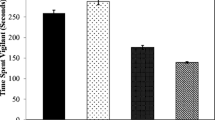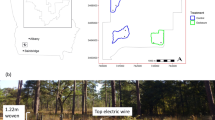Abstract
Predator stimuli created by humans in the urban environment may alter animals’ anti-predator behaviors. I hypothesized that habituation would cause anti-predator behaviors to decrease in urban settings in response to humans. Additionally, I hypothesized that populations habituated to humans would show reduced responses to other predator stimuli. I observed three populations of squirrels (urban, suburban and rural) responses to human approaches, red-tailed hawk vocalizations (Buteo jamaicensis) and coyote (Canis latrans) vocalizations. Mahalanobis distances of anti-predator behaviors in response to human approaches were consistent with the urban–rural gradient. Flight initiation distances (X 2 = 26.33, df = 2, P < 0.001) and amount of time dedicated to anti-predator behavior (X 2 = 10.94, df = 2, P = 0.004) in response to human approaches were also consistent with the urban–rural gradient. Supporting the habituation hypothesis, naive juvenile squirrels increased flight initiation distances (X 2 = 35.89, df = 1, P < 0.001) and time dedicated to anti-predator behaviors (X 2 = 9.46, df = 1, P = 0.002) relative to adult squirrels in the same urban environment. Time dedicated to anti-predator behaviors differed among all three sites in response to both coyote (X 2 = 9.83, df = 2, P = 0.007) and hawk (X 2 = 6.50, df = 2, P = 0.035) vocalizations. Responses to both vocalizations on rural sites (coyote = 45%, hawk = 55%) greater than twice that found on the urban sites (coyote = 11%, hawk = 20%). This is possibly the first case of a transfer of habituation demonstrated under field conditions.


Similar content being viewed by others
References
Adams LW (1994) Urban wildlife habitats; a landscape perspective. University of Minnesota Press, Minneapolis
Adams LW, Van Druff LW, Luniak M (2005) Managing urban habitats and wildlife. In: Braun CE (ed) Techniques for wildlife investigations and management. Allen, Lawrence, pp 714–739
Adams CE, Lindsey KJ, Ash SJ (2006) Urban wildlife management. Taylor & Francis, Boca Raton
Alcock J (2001) Animal behavior, 7th edn. Sinauer Associates, Sunderland
Anchor CL, Chelsvig JE, Etter DR, Hollis KM, Ludwig DR, Van Deelen TR, Warner RE (2002) Survival and movements of white-tailed deer in suburban Chicago, Illinois. J Wildl Manag 66:500–510. doi:10.2307/3803183
Berger J, Daneke D, Johnson J, Berwick SH (1983) Pronghorn foraging economy and predator avoidance in a desert ecosystem: implications for the conservation of large mammalian herbivores. Biol Conserv 25:193–208. doi:10.1016/0006-3207(83)90036-8
Berger J, Daneke D, Swenson E, Persson I (2001) Recolonizing carnivores and naïve prey: conservation lessons from pleistocene extinctions. Science 291:1036–1039
Blumstein DT (2002) Moving to suburbia: ontogenetic and evolutionary consequences of life on predator-free islands. J Biogeogr 29:685–692. doi:10.1046/j.1365-2699.2002.00717.x
Bowers MA, Breland B (1996) Foraging of gray squirrels on an urban-rural gradient: use of the GUD to assess anthropogenic impact. Ecol Appl 6:1135–1142. doi:10.2307/2269597
Brown J (1999) Vigilance, patch use and habitat selection: foraging under predation risk. Evol Ecol Res 1:49–71
Brown J, Laundre JW, Gurung M (1999) The ecology of fear: optimal foraging, game theory, and trophic interactions. J Mammal 80:385–399. doi:10.2307/1383287
Burger J, Gochfeld M (1981) Discrimination of the threat of direct versus tangential approach to the nest by incubating herring and great black-backed gulls. J Comp Physiol Psychol 95:676–684. doi:10.1037/h0077811
Burger J, Gochfeld M (1990) Risk discrimination of the threat of direct versus tangential approach by basking iguanas (Ctenosaura similis). J Comp Psychol 104:388–394. doi:10.1037/0735-7036.104.4.388
Chapman KA, Reich PB (2007) Land use and habitat gradients determine bird community diversity and abundance in suburban, rural and reserve landscapes of Minnesota, USA. Biol Conserv 135:527–541. doi:10.1016/j.biocon.2006.10.050
Conover MR (1997) Wildlife management by metropolitan residents in the United States: practices, perceptions, costs, and values. Wildl Soc Bull 25:306–311
Coss RG (1999) Effects of relaxed natural selection on the evolution of behavior. In: Foster SA, Endler JA (eds) Geographic variation in behavior: perspectives on evolutionary mechanisms. Oxford University Press, Oxford, pp 180–208
Curio E (1993) Proximate and developmental aspects of antipredator behavior. Adv Stud Behav 22:136–238
Dill LM (1974) The escape response of the zebra danio (Brachydanio rerio) II: the effect of experience. Anim Behav 22:723–730. doi:10.1016/S0003-3472(74)80023-0
Ditchkoff SS, Saalfeld ST, Gibson CJ (2006) Animal behavior in urban ecosystems: modifications due to human-induced stress. Urban Ecosyst 9:5–12. doi:10.1007/s11252-006-3262-3
Fernandez G (2003) Data mining using SAS applications. Chapman & Hall/CRC, Boca Raton
Frid A, Dill LM (2002) Human-caused disturbance stimuli as a form of predation risk. Conserv Ecol 6:11
Fritz H, Guillemain M, Durant D (2002) The cost of vigilance for intake rate in the mallard (Anas platyrhynchos): an approach through foraging experiments. Ethol Ecol Evol 14:91–97
Geeslin HG (1970) A radio-tracking study of home range, movements, and habitat uses of the fox squirrel (Sciurus niger) in east Texas. Thesis, Texas A&M University
Hinde RA (1954) Factors governing the changes in the strength of a partial inborn response, as shown by the mobbing behaviour of chaffinch (Fringilla coelebs). Proc R Soc Lond 142:331–358
Klecka WR (1980) Discriminate analysis. Sage University paper series. Quantitative applications in social sciences, series no. 07–019. Sage, Beverley Hills
Knight RL, Grout DJ, Temple SA (1987) Nest defense behavior of the American crow in urban and rural areas. Condor 89:175–177. doi:10.2307/1368772
Labra A, Leonard R (1999) Intraspecific variation in antipredator responses of three species of lizards (Liolaemus): possible effects of human presence. J Herpetol 33:441–448. doi:10.2307/1565641
Lima SL, Dill LM (1990) Behavioral decisions made under the risk of predation: a review prospectus. Can J Zool 68:619–640. doi:10.1139/z90-092
Lima SL, Valone TJ (1986) Influence of predation risk on diet selection: a simple example in the grey squirrel. Anim Behav 34:536–544. doi:10.1016/S0003-3472(86)80122-1
Lopez RR, Silvy NJ, Frank PA, Jones DA, Vieira MEP, Whisenant SW (2003) Survival, mortality, and life expectancy of Florida key deer. J Wildl Manag 67:34–45. doi:10.2307/3803059
Magle S, Zhu J, Crooks KR (2005) Behavioral responses to repeated human intrusion by black-tailed prairie dogs (Cynomys ludovicianus). J Mammal 86:524–530. doi:10.1644/1545-1542(2005)86[524:BRTRHI]2.0.CO;2
Marzluff JM, Bowman R, Donnelly R (2001) A historical perspective on urban bird research: trends, terms and approaches. In: Marzluff JM, Bowman R, Donnelly R (eds) Avian ecology and conservation in an urbanizing world. Kluwer, Norwell, pp 1–17
Matson P (1990) Special feature: the use of urban gradients in ecological studies. Ecology 71:1231. doi:10.2307/1938258
McCleery RA, Lopez RR, Silvy NJ, Gallant DL (2008) Fox squirrel survival in urban and rural environments. J Wildl Manag 72:133–137. doi:10.2193/2007-138
McDonnell MJ, Pickett STA (1990) Ecosystem structure and function along urban-rural gradients: an unexploited opportunity for ecology. Ecology 71:1232–1237. doi:10.2307/1938259
McDonnell MJ, Pickett S, Groffman P, Bohlen P (1997) Ecosystem processes along an urban-to-rural gradient. Urban Ecosyst 1:21–36. doi:10.1023/A:1014359024275
McFarland D (1993) Animal behaviour: psychobiology, ecology and evolution, 2nd edn. Longman Scientific and Technical, Harlow
Metcalf BM, Davis SJ, Ladd PG (2000) Adaptation behaviour by two bird species as a result of habituation to humans. Aust Bird Watch 18:306–312
Newman JA, Recer GM, Zwicker SM, Caraco T (1988) Effects of predation hazard of foraging “constraints”: patch-use strategies in the grey squirrel. Oikos 53:93–97. doi:10.2307/3565668
Olsson OJ, Brown S, Smith HG (2002) Long- and short-term state-dependent foraging under predation risk: an indication of habitat quality. Anim Behav 63:981–989. doi:10.1006/anbe.2001.1985
Randler C (2003) Vigilance in urban swan geese and their hybrids. J Waterbird Soc 26:257–260. doi:10.1675/1524-4695(2003)026[0257:VIUSGA]2.0.CO;2
Reimers E, Sigurd S (2001) Vigilance behavior in wild and semi-domestic reindeer in Norway. Alces 37:303–313
SAS Institute (1999) SAS/STAT user’s guide, version 9.1. SAS Institute, Cary
Steele MA, Koprowski JL (2001) North American tree squirrels. Smithsonian Institute Press, Washington
VanDruff LW, Bolen EG, San Julian GJ (1996) Management of urban wildlife. In: Bookhout TA (ed) Research and management techniques for wildlife and habits. Allen, Lawrence, pp 507–530
Ward C, Low BS (1997) Predictors of vigilance for American crows foraging in the urban environment. Wilson Bull 109:481–489
Weigl PD, Steele MA, Sherman LJ, Ha JC, Sharpe TL (1989) The ecology of the fox squirrel (Sciurus niger) in North Carolina: implications for survival in the southeast. Bull Tall Timbers Res Stn 24:1–93
Williams BK (1983) Some observations on the use of discriminate analysis in ecology. Ecology 64:1283–1291. doi:10.2307/1937836
Acknowledgments
I would like to thank Roel R. Lopez and Nova J. Silvy for their support during this project. I am grateful to Jane Packard who helped me formulate the ideas for this project. I would also like to thank the anonymous reviewers of this manuscript whose constructive criticism and editing suggestions greatly improved it. Thanks are extended to the undergraduate students whose hard work and dedication made this project possible. I also want to make a special note of the contributions of S. Kahlich and L. Gallant, whose countless hours trapping, and tracking fox squirrels made them invaluable. Funding and support was provided by the Ed Rachel Foundation and the Texas Agricultural Experiment Station.
Author information
Authors and Affiliations
Corresponding author
Rights and permissions
About this article
Cite this article
Mccleery, R.A. Changes in fox squirrel anti-predator behaviors across the urban–rural gradient. Landscape Ecol 24, 483–493 (2009). https://doi.org/10.1007/s10980-009-9323-2
Received:
Accepted:
Published:
Issue Date:
DOI: https://doi.org/10.1007/s10980-009-9323-2




